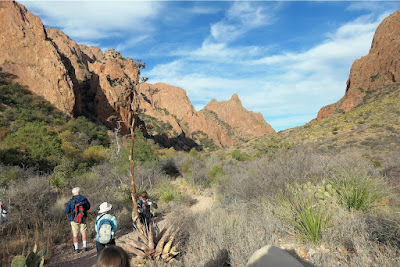Our main activity for the next day, March 11, 2023, was hiking the famous Window trail. This jaunt would be 5.5 miles round-trip, with an elevation change of 900 feet each way. After a short van ride to the campground we reached the trailhead. An early start meant cool temps and long shadows.
Volcanic mountains and running water created the Window. (Click on any image to enlarge.)A Havard Agave, which can reach up to 22 feet, impressed us.
We continued down the trail ...and the heights on either side drew closer.The ground of the stream bed absorbs enough water to support more vegetation.We continued to descend.Soon, we were definitely in a channel.Here, we're admiring a Texas Mountain Laurel.We were fortunate enough to see it blooming.The final stretch was so steep that it required stairs.We arrived at the window of the Window. We're at the top of a pouroff, the opposite of our visit to the Lower Burro Mesa Pouroff, where we stood at the bottom.As you would expect, the rushing water has scoured a smooth surface. Walk carefully!A fellow hiker provided scale for this photo.Some serious photographers (not I!) brought their equipment, inspected the angles, and waited their turn.This photo was taken from within the window. It doesn't look flat out there.
Then, it was time to head back ...On our way we spotted a scrub jay.After the long climb, including some pauses, we could look back and drink in the view. Six hours after setting out, the lighting was quite different.Zooming in on the gap created by the Window. The terrain beyond is more distinct at this hour.
Joan and I used the time before dinner to relax. She had done well on this extended hike, but wanted to give her ankle a rest. My final photo of the day is this view of the sunset looking towards the Window. The brighter object is Venus, the lesser Jupiter. The two had formed a conjunction two weeks earlier.
The next day we would leave the Chisos for our two-day return journey.
























































